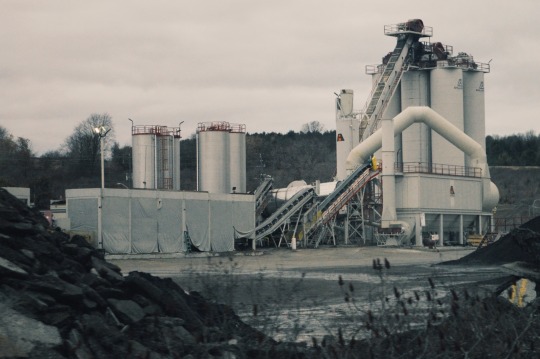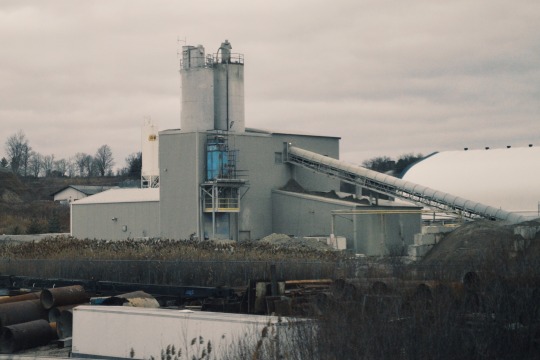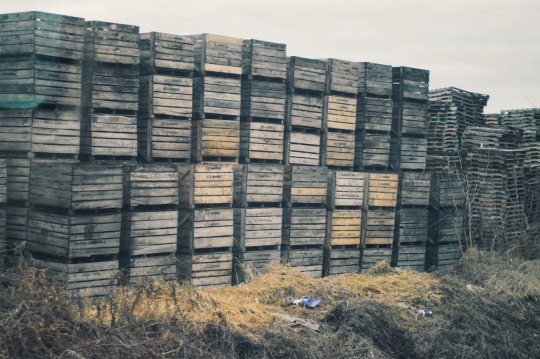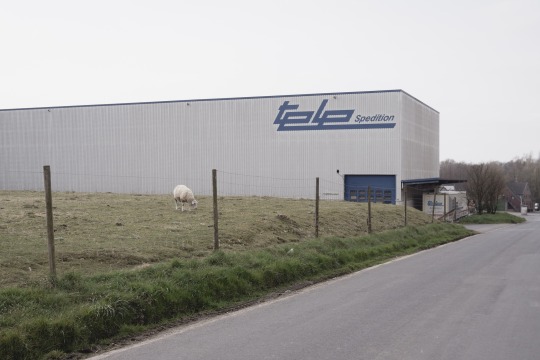#agricultural industries
Text
Researching herbicide resistance in weeds.
A decade ago, everyone said rotating applications of different herbicides was key to stopping herbicide resistance.
Then, around 2015, evidence from a large study emerged saying that this actually causes weeds to be MORE resistant, so the best thing to do is to spray a combination of multiple herbicides mixed together at once.
Now that is being called into question too. Whoda thunk it...
Herbicide resistance among weeds is only getting stronger. Recently, scientists found an annual bluegrass (Poa annua) on a golf course that was resistant to seven herbicide modes of action at once. Seven. SEVEN. Amaranth plants been found with resistance to six herbicide modes of action at once. Twenty years ago, the narrative was that resistance to glyphosate (Roundup) was unlikely to become widespread; today it's the second-most common type of resistance.
What's more, plants are developing types of herbicide resistance that are effective against multiple herbicides at once and harder to detect. Instead of changing the chemical processes within them that are affected by the herbicides so the herbicides don't work as well, they're changing the way they absorb chemicals in the first place. Resistant plants are producing enzymes that detoxify the herbicides before they even enter the plants' cells.
It took Monsanto ten years to develop crop varieties resistant to Dicamba (after weeds made 'Roundup Ready' crops pointless). Palmer amaranth evolved Dicamba resistance in five years.
So I asked, "Why are all the proposed solutions dependent on using more herbicides, when we know damn well that this is going to do nothing but make the weeds evolve faster?"
The answer is that chemical companies have the world in a death grip. They can't make money off non-chemical solutions, so chemical solutions get all the funding, research, and outreach to farmers.
But why do chemical companies have so much power?
One of the biggest reasons is the U.S. military.
In the Vietnam war, all of Vietnam was sprayed with toxic herbicides like Agent Orange, which was incredibly toxic to humans and affected the Vietnamese population with horrible illnesses and birth defects. Monsanto, the company that made the herbicides, knew that it did this, but didn't tell anyone. The US government didn't admit that they'd poisoned humans on a mass scale until Vietnam veterans started dying and coming down with horrible illnesses, and even then, it took them 40 years. (My Papaw died at 60 because of that stuff.) And the soldiers weren't there for very long. As for the Vietnamese people, the soil and water where they live is contaminated.
Similarly, during the "war on drugs," the US military sprayed Roundup and other chemicals on fields to destroy coca plants and other plants used in the manufacturing of drugs. This killed a lot of crops that farmers needed to live, and caused major health problems in places such as Columbia. The US government said that people getting sick were lying and that Roundup was just as safe as table salt. (A statement that did not age well.)
So chemical companies make money off arming the USA military. The American lawn care industry, and the agricultural system, therefore originates in more than one way from the United States's war-mongering.
The other major way is described in this article (which I highly recommend), which describes how after WW2, chemical plants used for manufacturing explosives were changed into fertilizer producing plants, but chemical companies couldn't market all that fertilizer to farmers, so they invented the lawn care industry. No exaggeration, that's literally what happened.
This really changes my perspective on all the writings about fixing the agricultural system. The resources are biased towards the use of chemicals in agriculture because the companies are so powerful as to make outreach and research for non-chemical methods of agriculture really hard to fund. All the funding is in finding new ways to spray chemicals or spraying slightly different chemicals, because that's what you can actually get ahold of money to look into. It is like the research has to negotiate a truce with the chemical companies, suggesting only solutions that won't cause lower profits.
Meanwhile my respect for Amaranth is skyrocketing.
Who would win: The USA military-industrial complex or one leafy boi
4K notes
·
View notes
Text
A key issue in understanding who feeds the world is the distinction between calories produced and calories delivered. Simply because a farming method produces a lot of calories, does not mean that those calories are going towards feeding people. Calories can be wasted or channeled into animal feed, biofuels, and other non-food uses, complicating how we assess methods for alleviating hunger. Emily Cassidy and her team studied this phenomenon across major agricultural countries. They found that in India, for example, 89% of produced crop calories went to feeding people during the study period. In Brazil, however, that number was 45%. In the United States, which produces the most gross calories out of any country studied, it was only 27%.
Backgrounder: Small Scale Farmers and Peasants Still Feed the World
654 notes
·
View notes
Link
“Across America, more than 20 state legislatures are looking over proposed laws that would help guarantee citizens’ access to parts, instructions, and diagnoses to help them repair products—from smartphones to tractors—in their own homes.
Called the “Right to Repair” movement, it’s been growing in urgency and size since the turn of the millennium, and 2023 could be the first year in many where the DIY capability of the American consumer grew, rather than diminished.
In Colorado, a bill was passed along party lines in the State House 9-4, mandating that tractor and other farm equipment manufacturers provide enough parts and instructions to allow farmers to repair their own tractors.
“The manufacturers and the dealers have a monopoly on that repair market because it’s lucrative,” said Rep. Brianna Titone, a Democrat and one of the bill’s sponsors. “(Farmers) just want to get their machine going again.”
Certain dealers like John Deere (previously) and Steiger don’t allow, as part of the buying agreement, fixes at home, but as an article in the Miami Herald points out, repairmen aren’t on call 24-7 in the high plains of Colorado. One farmer had to wait 5 days for a service on his tractor that stopped during a crucial period in the growing season, where he could have been losing as much as $83,000 a day.
Right to Repair farming legislation is on the table or has already passed in 10 states in the Union, including Colorado, but also Florida, Maryland, Missouri, New Jersey, Texas, and Vermont...
It’s not just tractors that are potentially becoming easier to fix at home, but automobiles as well.
This January, the Right to Equitable and Professional Auto Industry Repair Act was introduced into the House.
“The legislation would require all tools and equipment, wireless transmission of repair and diagnostic data, and telematics systems needed for vehicle repairs to be made available to the independent repair industry,” writes Automotive News.
The bill has come to the House after similar legislation was passed in Massachusetts and Maine, where lawmakers wanted to beef up the right-to-repair and aftermarket auto parts industry, especially regarding telematic data and other information from onboard computers.
Just as it wasn’t only tractors and farmers who felt their right to DIY repairs needed protecting, it isn’t only mechanical engineering where right-to-repair is flourishing.
The New York state Senate signed the Digital Fair Repair Act into law in the dying days of December, ensuring original equipment manufacturers make parts, instructions, and diagnostics data available to anyone looking to repair a device, such as a smartphone or tablet.
“As technology and smart devices become increasingly essential to our daily lives, consumers should be able to easily fix the devices they rely on in a timely fashion,” Governor Kathy Hochul said. “This legislation will empower consumers with better options to repair their devices, thereby maximizing the lifespan of their devices, saving money, and reducing electronic waste.” ...
“After a decade of trying, we get two [state laws] in a very short period of time,” Kyle Wiens, CEO of iFixit, told Axios.
“Every single day, I’m seeing a couple more states file a new bill. And I think we’re going to be over 20 states very soon and those bills are moving.”
There’s also something to be said for the ultimate end which consumers of many of these irreparable items are forced to make for them; they end up in landfills. E-waste is a potentially-catastrophic oncoming environmental problem since it doesn’t really biodegrade in any meaningful sense, and recycling it requires technical dismantling.
The right-to-repair is also equally about keeping easily-fixable devices out of the landfills.”
-via Good News Network, 2/14/23
#right to repair#diy#monopoly#big tech#tech industry#auto industry#tractor#farmers#agriculture#us politics#united states#colorado#maine#michigan#new york#good news#hope
810 notes
·
View notes
Text

Versatile Millstone Workhorse of Many Industries (Jon A. Sass)
65 notes
·
View notes
Text
i feel like it's obvious that between bb and kaz, kaz is the one that's better with money, but it's also worth pointing out that left to his own devices big boss canonically proceeds to dedicate 75% of zanzibarland's GDP to defense spending.
for context the highest in the world (oman) is 12%.
big boss is that dril tweet about candles except it's guns.
#mgs#big boss#not sure if it makes if better or worss that ZL is a tiny former soviet country with only mining and agriculture industries#so it probably has no money to begin with
220 notes
·
View notes
Text
youtube
Things I like
-Most birds are active and in good spirits
-no beak mutilation
-bedding in the indoor area looks clean and cozy and good for dust batheing
-plenty of natural safe enrichment. You don't want very tall perches for battery hens they could break a bone.
-Communal roosting
-cockerels used for meat rather than culled at a day old
-use of solar for energy
-when the birdflu isn't a threat they have outdoor pastures the birds can access anytime during foraging time.
-natural daylight
Things I don't like
-birds seem dirty due to communal roosting situation, they are getting pooped on basically. Changing the layout to a almost look like stairs would probably help.
-some birds still show evidence of feather picking, obviously not as bad as American battery farms but always room for improvement. They didn't have as much evidence of this when they could go outside but unfortunately they can't right now for their own safety.
-their feed regime might contribute to the feather picking behavior and poor feather quality if they are truly only using byproducts in their feed. Wheat,soy, and corn byproducts are harder on a chickens gut microbiome than better ingredients.
Things to note-
-Leghorns are more prone to neurotic behaviors than other breeds (this can happen when you take a flighty land race and turn it into a production animal) if they had a different production breed they might see less feather picking. I think they chose pure production leghorns on purpose for sustainability reasons so can't fault them for that.
Their feathers will likely always look a bit shit. White feathers are structurally weaker than pigmented ones and that goes pretty much for all birds.
The feathers you see on the ground are just molted not from plucking of anything like that.
What do you think fellow chicken keepers?
39 notes
·
View notes
Note
people really be out there like “I wonder what this breed called a Shetland sheepdog was used for historically? alas it’s impossible to tell, we may never know” 🤦♀️
There is, believe it or not, some actual controversy regarding the breed origins and most of it (imo) stems from many people's mental image of a working sheepdog is a border collie, and not quite grasping that border collies are freaks and the way that we now work border collies didn't exist prior to the development of the border collie, and in some parts the way we keep SHEEP didn't exist prior to the border collie. There's also been some debate around old letters written by non-shetlanders after visiting the isles or talking to locals and having mmm interesting ideas of how people handled sheep over there. This leads to statements like:
Sheltie legs are too short to outrun sheep
They're also too small to grab the sheep and hold it (don't get me started)
A sheltie could never take sheep through a- (name specific type of herding trial)
Maybe they were actually placed with flocks on peripheral islands to keep watch for birds??
Shelties never existed and were made up in the late 1800s just for shetlanders to make money off of selling cute puppies to gullible tourists
There was an original sheepdog on Shetland but it was a much bigger dog (see reasons above) and the current sheltie was made up in the late 1800s, by breeding cavaliers to pomeranians and maybe a collie, just for shetlanders to sell puppies to tourists
...and so, clearly, they can't have been sheepdogs and we have No Clue what they were actually for (except scamming foreigners)
Meanwhile we know that traditional shepherding on Shetland relied on roaming sheep, keeping them off the property rather than on it (because that's where your crops are) and you'd only be rounding up your sheep a couple of times a year, and that island-bred shelties were smaller and spitzier type than even the current UK type.
#life is full of mysteries#and like. i know i have a particular interest in this because I'm interested in the historical development of Norwegian agriculture#and how that has been shaped by industry and politics because that is very much an ongoing issue#and that we have a similar climate and heritage breeds with similar traits and origins#and i grew up in this. and how we live and how we have lived and the animals involved in that is yknow. part of our cultural identity#and it MATTERS.#and so i have pegs to hang it on#and it baffles me#how short our memory is and how little imagination we have for how things have been done in the past
86 notes
·
View notes
Text
Quebec Labour Minister Jean Boulet has amended his law project, Bill 19, regulating youth employment in the province to allow children under 14 to work in agriculture, provided the business has a maximum of 10 employees.
The proposed law, tabled in March, would limit the number of weekly hours Quebecers 16 and under can work during the school year to 17. It also sets the minimum legal working age at 14 — with some exceptions for jobs like babysitting or tutoring.
But Boulet's amendment would allow small agricultural businesses to be exempt from the new minimum working age and employ children as young as twelve.
[...]
This new exemption echoes the demands of employers, who asked for more exceptions to allow children under 14 to work.
But there are concerns over the agricultural environment being risky as injuries in young people are frequent. Some doubt the ability of Quebec's labour regulator, La Commission des normes, de l'équité, de la santé et de la sécurité du travail (CNESST), to ensure the safety of children in the workplace.
Full article
Tagging: @allthecanadianpolitics
#cdnpoli#canada#canadian news#canadian politics#québec#quebec#child labour#workers rights#children's rights#labour#agriculture#agricultural industry#jean boulet#bill 19#workplace safety#mine#what the fuck man#la commission des normes de l'équité de la santé et de la sécurité du travail#CNESST#child labour laws
192 notes
·
View notes
Text
Former officials in the UN’s farming wing have said they were censored, sabotaged, undermined and victimised for more than a decade after they wrote about the hugely damaging contribution of methane emissions from livestock to global heating.
Team members at the UN Food and Agriculture Organization (FAO) tasked with estimating cattle’s contribution to soaring temperatures said that pressure from farm-friendly funding states was felt throughout the FAO’s Rome headquarters and coincided with attempts by FAO leadership to muzzle their work.
The allegations date back to the years after 2006, when some of the officials who spoke exclusively to the Guardian on condition of anonymity wrote Livestock’s Long Shadow (LLS), a landmark report that pushed farm emissions on to the climate agenda for the first time. LLS included the first tally of the meat and dairy sector’s ecological cost, attributing 18% of global greenhouse gas emissions to livestock, mostly cattle. It shocked an industry that had long seen the FAO as a reliable ally – and spurred an internal clampdown by FAO hierarchy, according to the officials.
“The lobbyists obviously managed to influence things,” one ex-official said. “They had a strong impact on the way things were done at the FAO and there was a lot of censorship. It was always an uphill struggle getting the documents you produced past the office for corporate communications and one had to fend off a good deal of editorial vandalism.”
Serving and former FAO experts said that between 2006 and 2019, management made numerous attempts to suppress investigations into the cow/climate change connection. Top officials rewrote and diluted key passages in another report on the same topic, “buried” another paper critical of big agriculture, excluded critical officials from meetings and summits, and briefed against their work.
"There was substantial pressure internally and there were consequences for permanent staff who worked on this, in terms of their careers. It wasn’t really a healthy environment to work in,” said another ex-official.
Scientists also expressed concern about the way the FAO’s estimate of livestock’s overall contribution to emissions is continuing to fall. The 18% number that was published in 2006 was revised downwards to 14.5% in a follow-up paper, Tackling Climate Change Emissions in 2013. It is currently being assessed at about 11.2% based on a new “Gleam 3.0” model.
But many scientists plot farm emissions on a very different trajectory. One recent study concluded that greenhouse gas emissions from animal products made up 20% of the global total and a 2021 study found that the figure should be between 16.5% and 28.1%.
#agriculture#united nations#climate change#greenhouse gasses#methane emissions#animal agriculture#farming#industry#capitalism#greed
57 notes
·
View notes
Text
youtube
Oregon [usa] has been shutting down small farms and market gardens in a pretty aggressive manner. They're even resorting to sending out cease and desist letters to these farms, using satellite tech to track them down first. Their justification? Water conservation and protecting groundwater. They're wielding two laws in particular to make this happen.
#agriculture#home gardens#farmer markets homesteads#or usa#usa#small market#gov over reach#big brother#spy in the sky#cease and desist#big ag exept#industrial ag exempt#gov against those that want to grow their won food and feed they communities#neighbors encouraged to snitch via hotline#pretense of water conservation#water rights#water protection#death of small holdings#private wells made public ownership of state#bill gates#gladstone
33 notes
·
View notes
Note
hello! I've just found your blog and that's AMAZING, but I have a question: what do you think about industrial food? it's super low quality, and furthermore, they produce a lot of trash as plastic (unnecessary) packaging! It would be easier just to say "starting eating organic food", but for poor people, buying grapes or apples, even not organic, costs more than buying cookies full of fat, sodium and carbohydrates (not talking about all the chemicals). I personally, think about non conventional food plants as an alternative since most of them are super resistant to weather changes and easy to rise. I wanna know what you think about
Hi! Thanks for getting in touch. The long and short of it is, I hate industrialised farming. It pollutes the air, soil and water, poisons and impoverishes farmers, increases the likelihood of zoonotic pandemics, reduces the genetic diversity of plants and encroaches upon wildlife territories. We need a massive return to local, small-scale regenerative agriculture if we are to feed everyone and equitably share the earth with other species. But you’re right, it has to be done in a way that’s just and fair for people who can currently only afford plasticked, pesticided and processed food, as well as making a living for farmers. We’re all on the same side here, but people often don’t realise that. I also think we need to massively diversify our food plant range - a system that relies on just a few staple crops is insanely vulnerable, especially with more and more extreme weather coming our way. So many plants I was raised to think of as ‘weeds’ are not only edible but highly nutritious and often medicinal. Where are the dandelion farmers? The mycologists selling turkey tails? And foraging should be taught in all schools so kids can feed themselves in the wild and pass these skills on to future generations. As with most climate solutions, I don’t think it’s an either/or - I’d welcome pretty much any solution as part of a wider melting pot of alternatives. The only thing I won’t budge on is that we have to change, because the way we in the North and West farm right now just isn’t sustainable.
#solarpunk#hopepunk#cottagepunk#environmentalism#social justice#community#farming#food systems#organic#agriculture#agroecology#regenerative farming#plants#foraging#diet#ask#fuck industrial farming
20 notes
·
View notes
Text
The standard legend of India’s Green Revolution centers on two propositions. First, India faced a food crisis, with farms mired in tradition and unable to feed an exploding population; and second, Borlaug’s wheat seeds led to record harvests from 1968 on, replacing import dependence with food self-sufficiency.
Recent research shows that both claims are false.
India was importing wheat in the 1960s because of policy decisions, not overpopulation. After the nation achieved independence in 1947, Prime Minister Jawaharlal Nehru prioritized developing heavy industry. U.S. advisers encouraged this strategy and offered to provide India with surplus grain, which India accepted as cheap food for urban workers.
Meanwhile, the government urged Indian farmers to grow nonfood export crops to earn foreign currency. They switched millions of acres from rice to jute production, and by the mid-1960s India was exporting agricultural products.
Borlaug’s miracle seeds were not inherently more productive than many Indian wheat varieties. Rather, they just responded more effectively to high doses of chemical fertilizer. But while India had abundant manure from its cows, it produced almost no chemical fertilizer. It had to start spending heavily to import and subsidize fertilizer.
India did see a wheat boom after 1967, but there is evidence that this expensive new input-intensive approach was not the main cause. Rather, the Indian government established a new policy of paying higher prices for wheat. Unsurprisingly, Indian farmers planted more wheat and less of other crops.
Once India’s 1965-67 drought ended and the Green Revolution began, wheat production sped up, while production trends in other crops like rice, maize and pulses slowed down. Net food grain production, which was much more crucial than wheat production alone, actually resumed at the same growth rate as before.
But grain production became more erratic, forcing India to resume importing food by the mid-1970s. India also became dramatically more dependent on chemical fertilizer.
According to data from Indian economic and agricultural organizations, on the eve of the Green Revolution in 1965, Indian farmers needed 17 pounds (8 kilograms) of fertilizer to grow an average ton of food. By 1980, it took 96 pounds (44 kilograms). So, India replaced imports of wheat, which were virtually free food aid, with imports of fossil fuel-based fertilizer, paid for with precious international currency.
Today, India remains the world’s second-highest fertilizer importer, spending US$17.3 billion in 2022. Perversely, Green Revolution boosters call this extreme and expensive dependence “self-sufficiency.”
106 notes
·
View notes
Text







Industrial Conversion, Gent - GAFPA
#GAFPA#architecture#design#building#modern architecture#house#interiors#concrete#minimal#house design#industrial#extension#renovation#old and new#agricultural#courtyard#living room#belgium#ghent#cool architecture
74 notes
·
View notes
Text






Southern Ontario right before the snow comes
#my photography#ontario#winter#banal#industrial photography#grain elevator#rail#agriculture#asphalt#manufacturing#new topographics#banal photography#mundane photography#liminal#heavy industry#function
38 notes
·
View notes
Photo

logistics company in rural environment –
near smaller town in lower rhineland, germany // 04-2016
© 2016 waidwund-photo
#original photographers#photographers on tumblr#rural exploration#industrial#agriculture#still life#waidwund photo#josch schlegel#traces of human life
119 notes
·
View notes
Text
BlackRock Recruiter Who ‘Decides People’s Fate’ Says ‘War is Good for Business' Undercover Footage
youtube
#blackrock#james o'keefe#campaign finance#hedge funds#wall street#politics#military industrial complex#russia#ukraine#economy#agriculture#market manipulation#o'keefe media group#political manipulation#ESG#propaganda#war propaganda#war profiteers#Youtube
58 notes
·
View notes